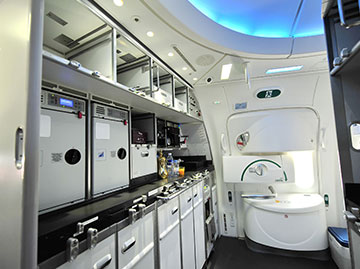Correct management of an abnormal situation and effective crew coordination ensured the safe return of a United Airlines Boeing 787 to Sydney on 17 April this year.

An Australian Safety Transport Bureau (ATSB) investigation found that all emergency procedures were carried out efficiently and effectively. The captain involved all relevant crewmembers and the ground-based technical operations maintenance controller (TOMC) in making a decision to return the aircraft to Sydney.
The situation occurred when a faulty oven resulted in smoke and fumes setting off a fire alarm on the San Francisco-bound flight UAL870, comprising 238 passengers, 11 cabin crew and four flight crew.
During departure, cabin crew switched on the aft galley ovens in preparation for meal services. After the two ovens were switched on, there was a short burst of smoke, with one of the ovens displaying a “FAILURE” message.
Several cabin crew detected a strong chemical odour and an electrical smell, as well as a blue haze. Other crew described it as an ozone smell. The oven interactive screen displayed a ‘Critical Error- Broken Fuse’ message.
The crew immediately pulled all relevant circuit breakers, and switched off all electrical sources to the aft galley. The inflight service manager (ISM) advised the captain. The ISM and a relief pilot from the cockpit arrived at the aft galley with fire extinguishers. By this stage, the smoke had dissipated, but the odour persisted. As it could not be confidently ascertained that the ovens were the sole source of the problem, the captain contacted the TOMC by satellite phone.
The discussion with the TOMC involved all flight crew and the ISM. It was agreed that the safest option was to return the aircraft to Sydney. The captain advised ATC by a PAN call. ATC initiated an INCERFA phase. About 110 km east of Port Macquarie, NSW, the crew commenced a return to Sydney. As the aircraft was well in excess of its allowed landing weight, fuel was dumped during the descent.
The aircraft landed without incident in Sydney at 1258 Eastern Standard Time (EST) with emergency services attending.
A post-engineering inspection quarantined the suspect oven, and after an inspection, a fuse was replaced. After appropriate testing, the aircraft was released back to service.
Boeing and the oven manufacturer investigated the cause of the ‘Critical Error’ fault displayed on the oven screen. The manufacturer individually tested all oven components. They reported that all individual components worked correctly, however, an additional measurement of the oven motor current detected that the motor did not run smoothly. The motor temperature was also above normal, most likely from insufficient airflow. This known fault had been rectified with a new oven software release.
Boeing reported that the oven manufacturer was working with United Airlines to update the software in all relevant ovens in their fleet. The exact cause of the odour could not be determined.
Read the final report: Smoke and fumes event involving Boeing 787, N36962, 110 km east of Port Macquarie, New South Wales, on 17 April 2016


